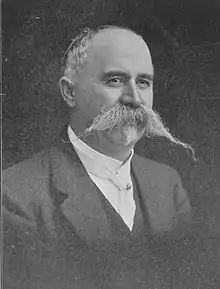Thomas Bakhap
Thomas Jerome Kingston Bakhap (29 October 1866 – 18 August 1923) was an Australian politician. He was born in Ballarat, Victoria, the adoptive son of a Chinese immigrant, Bak Hap.[1] He received no formal education but became a shopworker, and was later a tin miner at Lottah, Tasmania. In 1909, he was elected to the Tasmanian House of Assembly for Bass.[2] In 1913, he transferred to federal politics, winning a Tasmanian Senate seat as a member of the Commonwealth Liberal Party. He was Chairman of Committees from July 1920 to June 1923.[3] Bakhap died in August 1923; John Hayes was appointed to replace him.[4] Bakhap was fluent in Cantonese. He advocated for the Chinese community when Chinese Australians encountered problems arising from the application of the White Australia Policy. He visited China in 1922[5] as a representative of the Australian government, and by that time was recognised as the parliament's pre-eminent expert in Chinese and South-East Asian affairs.[6]
Thomas Bakhap | |
|---|---|
 | |
| Senator for Tasmania | |
| In office 1 July 1913 – 18 August 1923 | |
| Succeeded by | John Hayes |
| Personal details | |
| Born | 29 October 1866 Ballaarat, Victoria |
| Died | 18 August 1923 (aged 56) Launceston, Tasmania, Australia |
| Political party | Liberal (1913–17) Nationalist (1917–23) |
| Occupation | Politician |
References
- National Museum of Australia: Harvest of Endurance Scroll – Thomas Jerome Bakhap profile, nma.gov.au. Accessed 3 August 2023.
- "Thomas Jerome Kingston Bakhap". Members of the Parliament of Tasmania. Retrieved 26 July 2022.
- "Appendix 3―Deputy Presidents and Chairmen of Committees (1901–2009)". Parliament of Australia. Retrieved 10 September 2017.
- Carr, Adam (2008). "Australian Election Archive". Psephos, Adam Carr's Election Archive. Retrieved 23 November 2008.
- The Australian People: An Encyclopedia of the Nation, Its People and Their Origins, James Jupp, Cambridge University Press, 2001
- Rubinstein, Hilary (2000). "Bakhap, Thomas Jerome Kingston (1866–1923)". The Biographical Dictionary of the Australian Senate. Retrieved 2 February 2020.